Research & Development
JAXA promotes three research and development programs and a fundamental research program that underpins them.
Research on hypersonic turbojet engine
Please visit " Research on technology for applying hydrogen fuel to aircraft and future space transportation systems " for further updates.
JAXA has been promoting research and development to establish technologies for a Mach 5 class hypersonic passenger aircraft that can cross the Pacific Ocean in 2 hours. Hypersonic passenger aircraft flying at Mach 5 will be exposed to higher temperature environments than supersonic aircraft flying at around Mach 2. Therefore, research and development of a new engine and a heat-resistant structure are necessary.
With the main focus on research and development of hypersonic turbojet engine that can operate continuously from takeoff to Mach 5, our R&D in this field also include system analysis of hypersonic passenger aircraft, aerodynamic design, heat resistance design, and other important features.
Research and development of hypersonic turbojet engine
Aiming at the technical demonstration of a hypersonic turbojet engine, we have been promoting the research and development of a small demonstration engine of 1 kN class thrust. Our efforts at designing and manufacturing a hypersonic turbojet engine for technical demonstrations started in 2004, which we successfully demonstrated in 2008 for the first time in the world through engine system demonstration experiments simulating a taking-off state.
When flying at Mach 5, temperatures at the intake outlet area, where the air stream is slower, reach as high as 1,000°C. To solve this problem, we are applying "pre-cooling" to the hypersonic turbojet engine, making use of the extremely cold characteristics of the fuel, cryogenic liquid hydrogen, to cool the high-temperature air down to about 300°C, which is an acceptable temperature for the core engine. Because of the higher air density created by cooling, such a pre-cooled system enables the hypersonic turbo jet engine to operate continuously with increasing engine thrust from takeoff to Mach 5 speed.

The hypersonic turbojet engine consists of the following major components:
- Variable geometry air intake: Duct to reduce air speed at Mach 5 to less than Mach 1
- Pre-cooler: Heat exchanger to cool high-temperature air using low-temperature liquid hydrogen
- Core engine: Jet engine to compress air and generate high-pressure gas
- Afterburner: Combustor to generate high-temperature combustion gas and a variable geometry nozzle that regulates the combustion pressure
Aiming at establishment of key technologies of a hypersonic turbojet engine, we are examining the validity of a small demonstration engine with a heat-resistant design.
In the near future, we are going to assess and improve the propulsive performance of the hypersonic turbojet engine using the "Ramjet engine testing facility" (JAXA Kakuda Space Center), which is capable of simulating Mach 5 flight conditions.
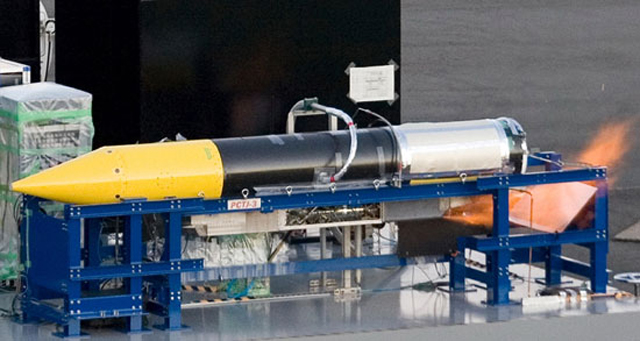
Sea-level static firing tests of a hypersonic turbojet engine
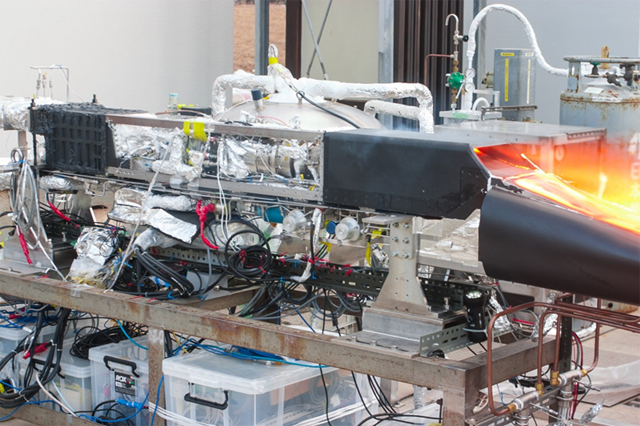
Hypersonic turbojet engine Mach 4 simulation environment experiment
Systems analysis of hypersonic passenger aircraft
We have been conducting systems analysis necessary for the hypersonic passenger aircraft that have 100 seats and operates between Tokyo and Los Angeles with Mach 5 cruise speed. Using a multi-disciplinary optimization program, we derived an optimal design that minimizes the airframe mass. For configuration analysis, we have been examining the layout of components such as the passenger cabin, fuel tank, and landing gear. Based on results of our analyses, the optimal layout includes placement of the liquid hydrogen fuel tanks at the front and rear of the airframe so that the center of gravity is moved appropriately from takeoff to hypersonic flight to ensure stable flight.
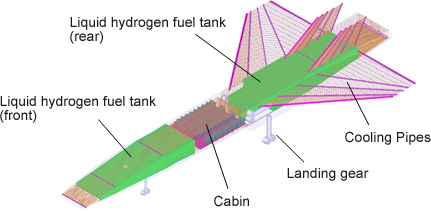
Aerodynamic design of hypersonic passenger aircraft
We are promoting studies of aircraft aerodynamic configurations for hypersonic passenger aircraft that can carry an adequate volume of fuel for long-distance flight at hypersonic speeds, while maintaining high-lift and low drag.
To obtain and improve a configuration that ensures both cruising flight at Mach 5 and taking off and landing, aerodynamic performance has been evaluated through wind tunnel testing and numerical analyses.
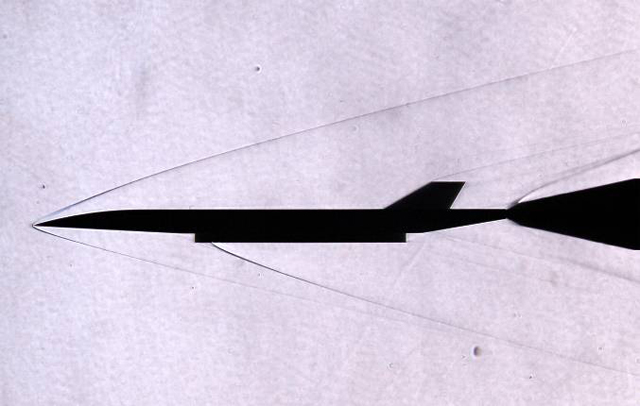
Hypersonic wind tunnel test (Mach 5)
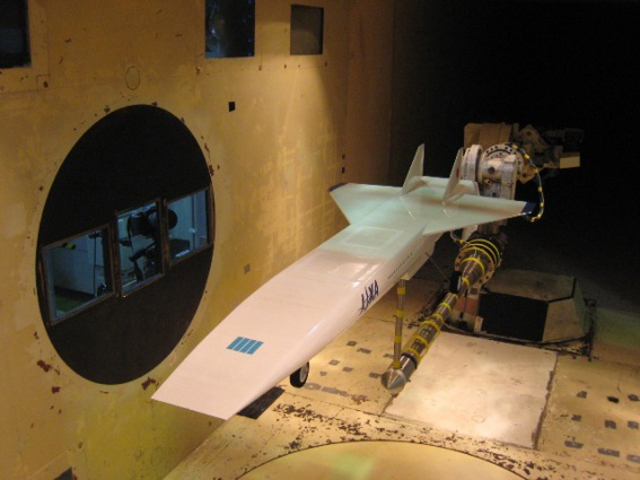
Low-speed wind tunnel test (wind speed: 30 m/s)
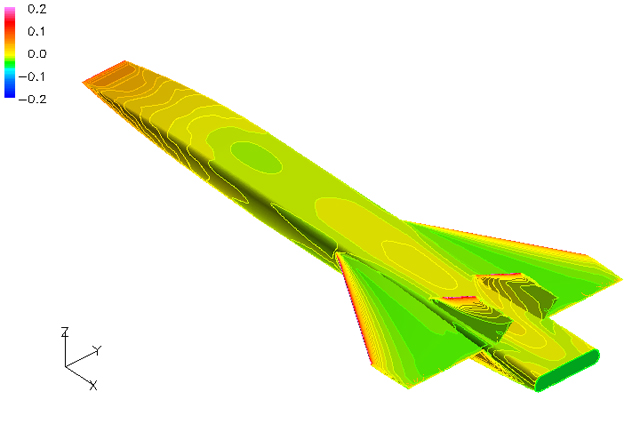
Numerical analysis of hypersonic passenger aircraft (Mach 5)
Heat-resistant design of hypersonic passenger aircraft
We are investigating the use of thermal barrier walls to suppress heat transfer from high-temperature environments at cruising flight at Mach 5. A heat management system is also investigated to maintain the cabin and airframe structure temperature at a constant level. Using hypersonic wind tunnel experiments, the temperature distribution on the airframe surface are examined. Based on these examinations, we are analyzing elements necessary for the thermal barrier wall, such as applying lightweight and heat-resistant composite materials such as silicon-carbide for the fuselage, where the temperature becomes highest, as well as for the fore-end of the main wing.
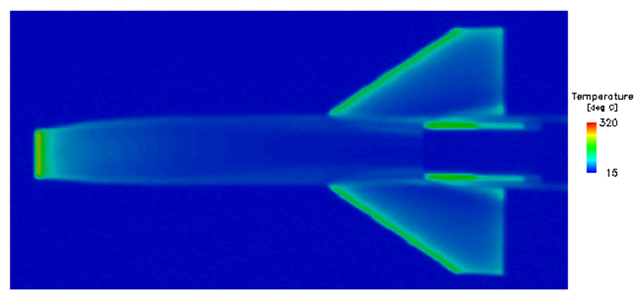
Temperature distribution obtained by hypersonic wind tunnel experiment
Investigation of a hypersonic technology experimental aircraft
Aiming at demonstration of flight environments of hypersonic turbojet at Mach 5, we are investigating an experimental aircraft incorporating hypersonic technology. After the experimental aircraft is accelerated by external acceleration means such as a solid rocket motor, the engine performance at Mach 5 cruising flight will be assessed.
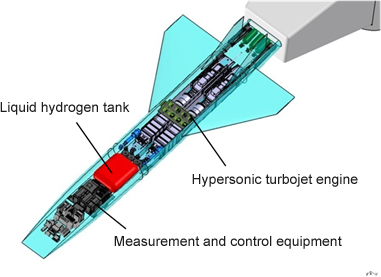
A New Dream for Humanity - Hypersonic Transport Aircraft - (5:50)